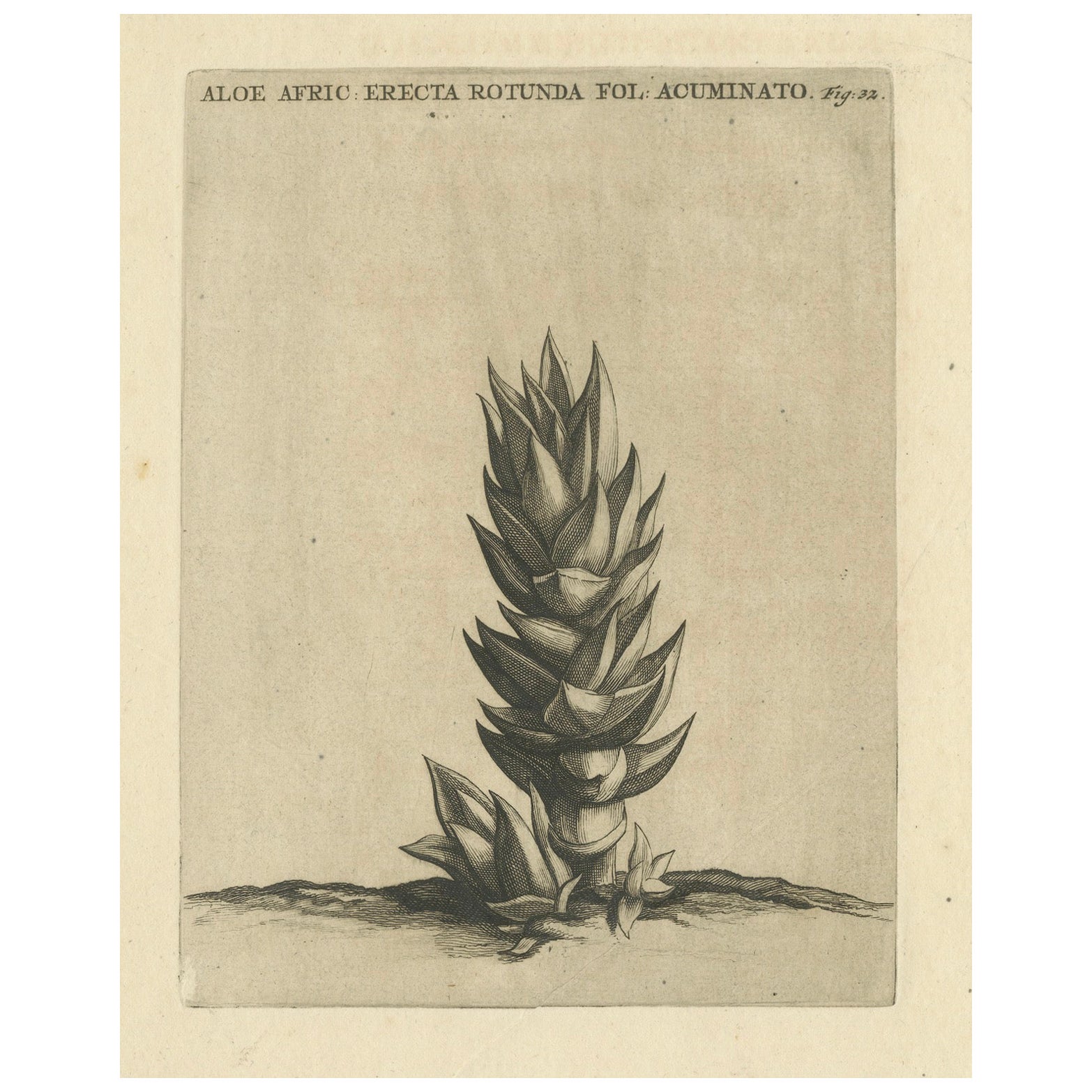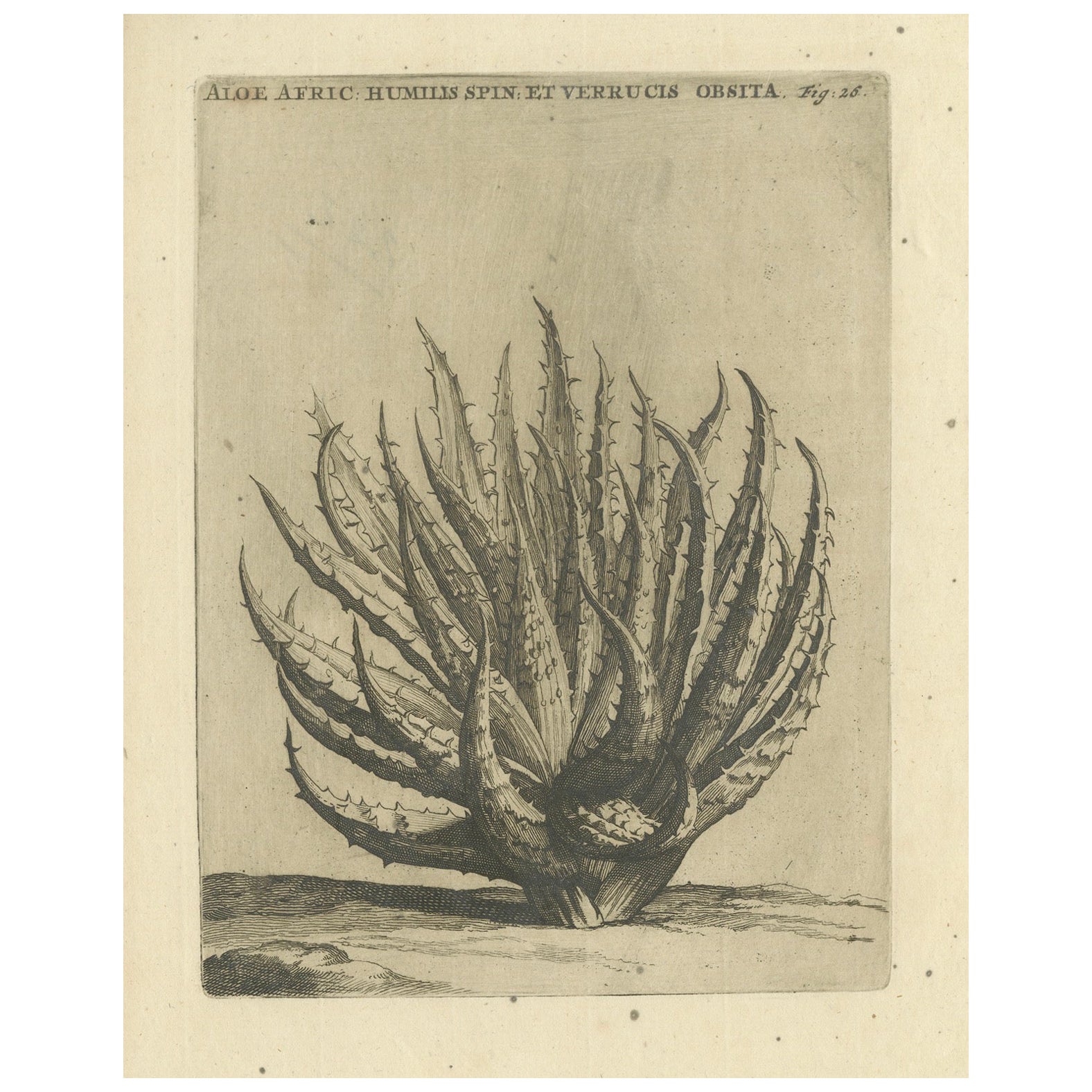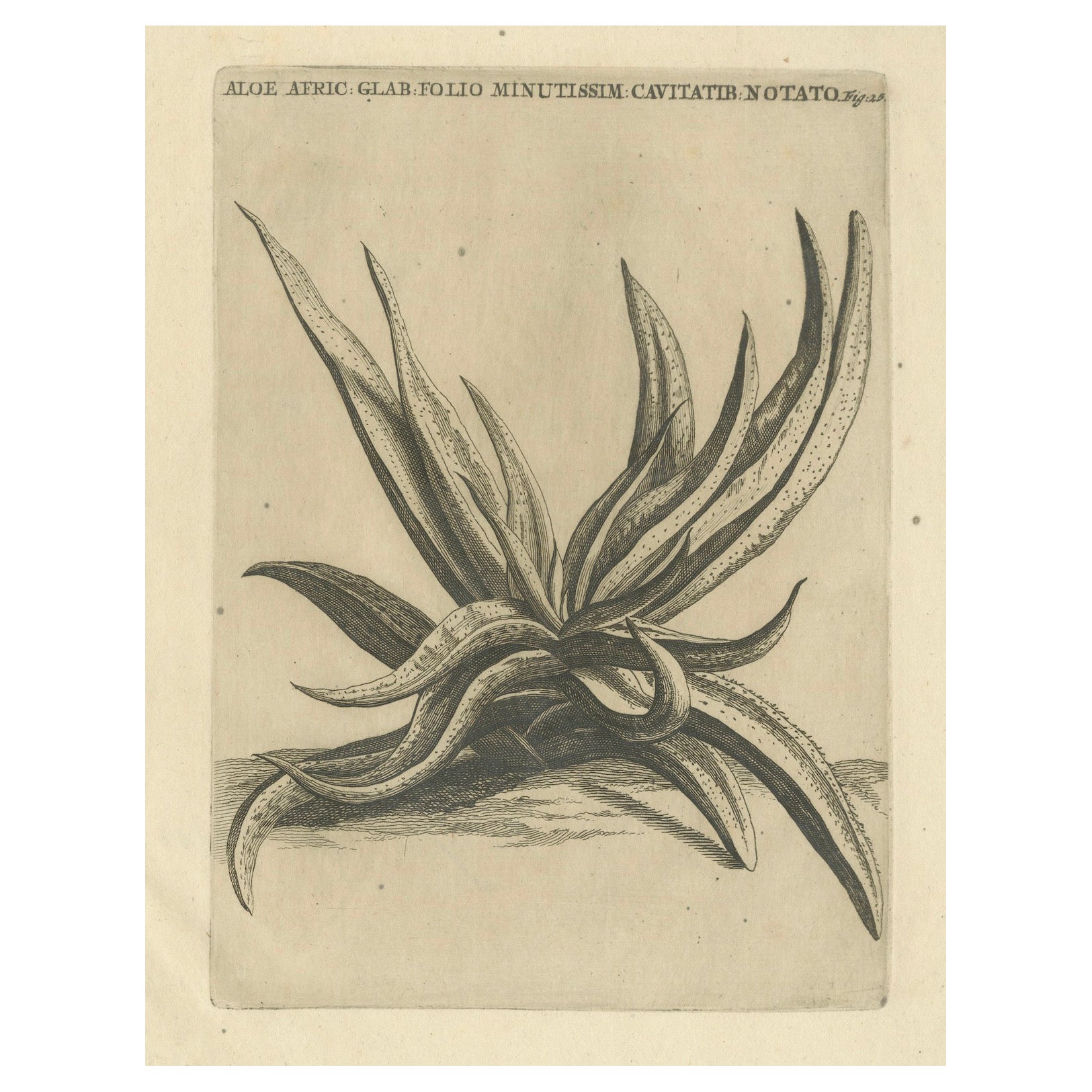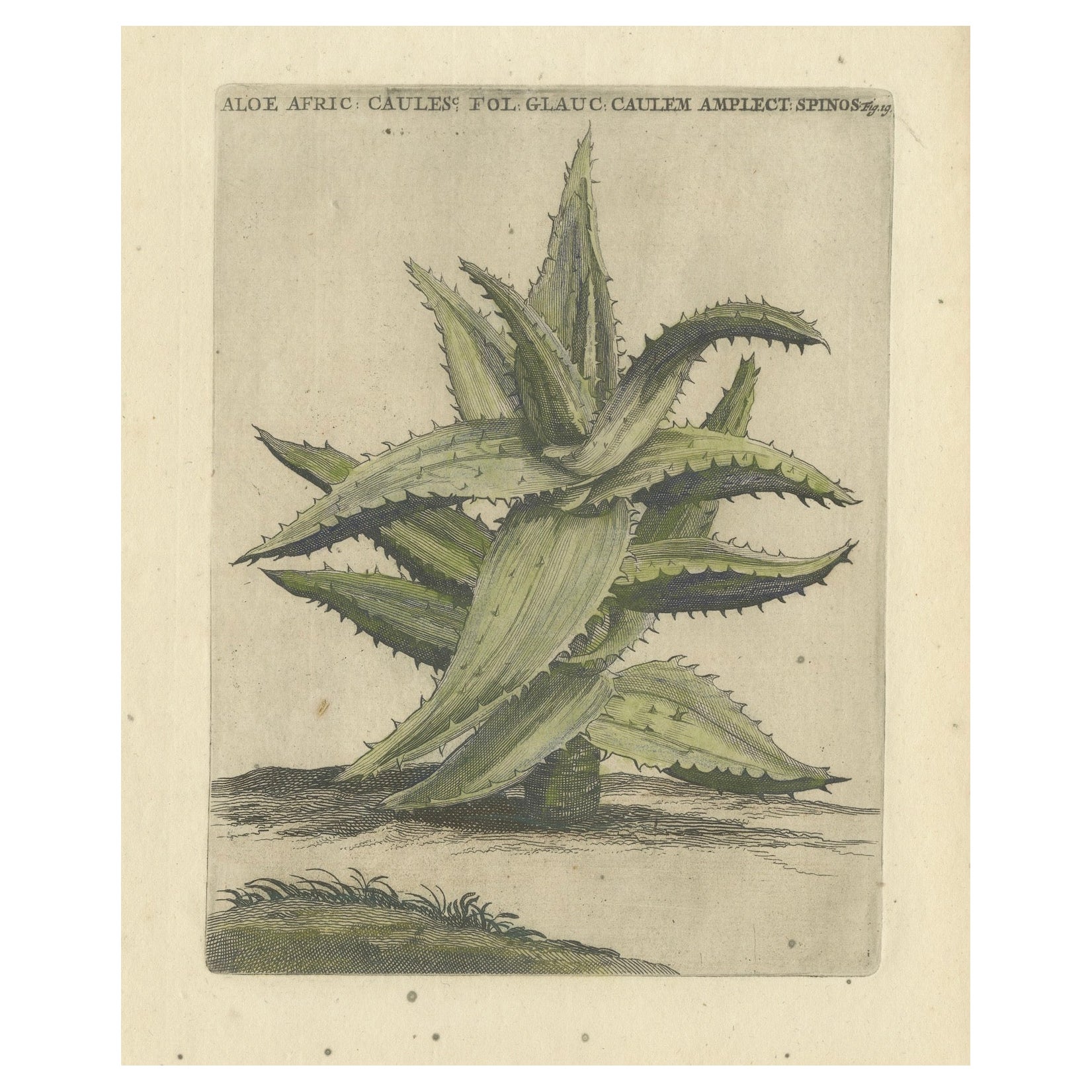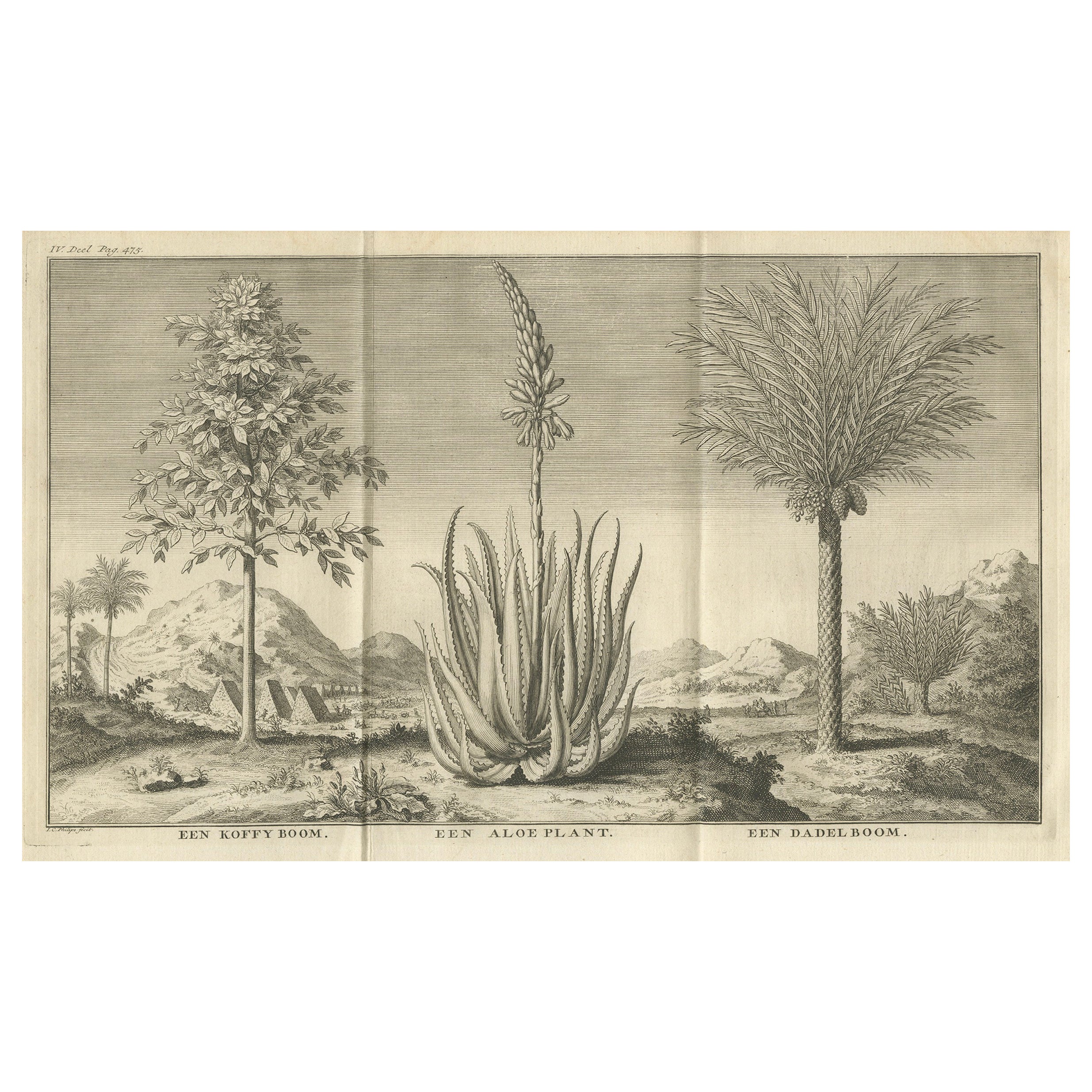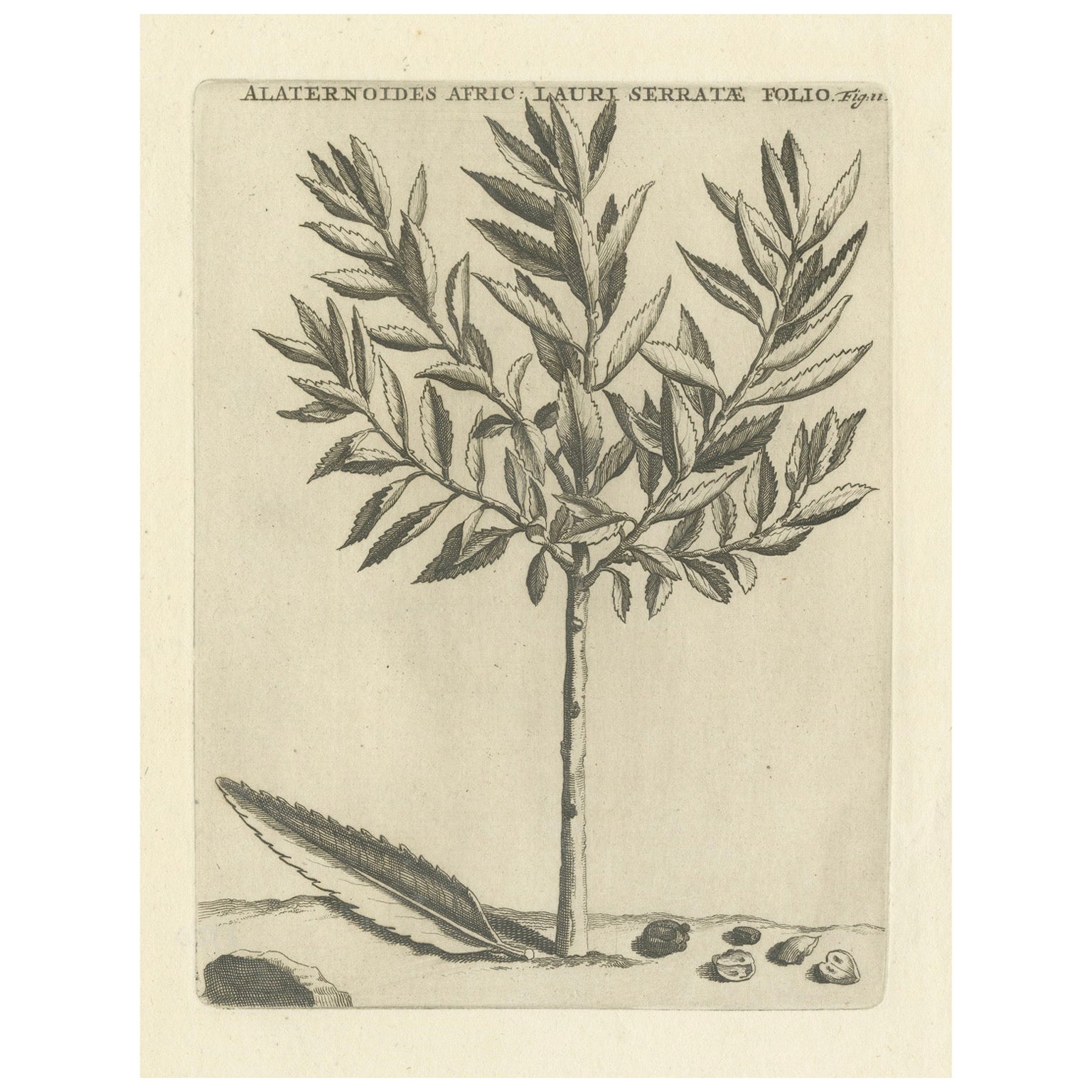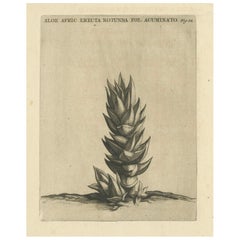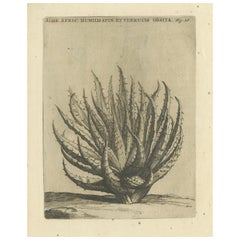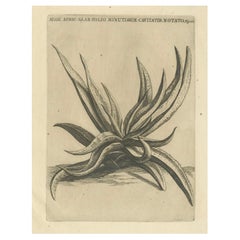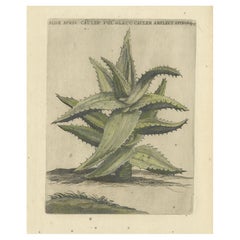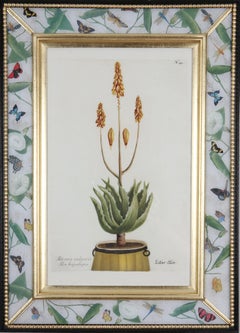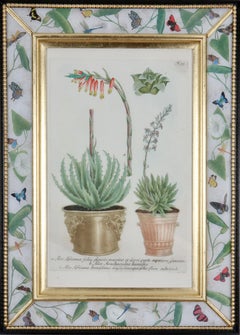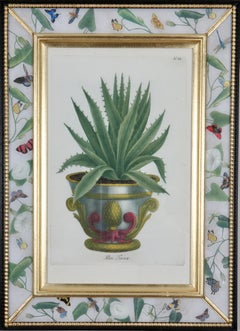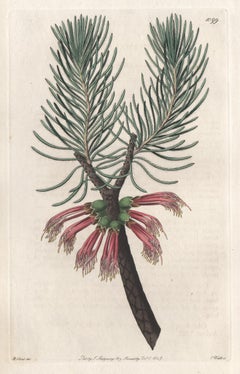Items Similar to Aloe Humilis Africana Botanical Engraving from Caspar Commelin's Work, 1706
Want more images or videos?
Request additional images or videos from the seller
1 of 13
Aloe Humilis Africana Botanical Engraving from Caspar Commelin's Work, 1706
$275.76
$344.7020% Off
£205.36
£256.7020% Off
€232
€29020% Off
CA$380.73
CA$475.9120% Off
A$422.09
A$527.6120% Off
CHF 221.83
CHF 277.2820% Off
MX$5,165.70
MX$6,457.1320% Off
NOK 2,770.37
NOK 3,462.9720% Off
SEK 2,600.27
SEK 3,250.3420% Off
DKK 1,766.37
DKK 2,207.9620% Off
About the Item
Aloe Humilis Africana Botanical Engraving from Caspar Commelin's Work, 1706
This engraving is possibly a botanical illustration from Caspar Commelin's "Praeludia Botanica," published in 1703. It depicts Aloe Humilis Africana Arachnioidea, a low-growing African aloe species with a tall flowering stalk. The title in Latin translates to "Low African Aloe, Spider-Like," likely referring to the fine texture and structure of the plant's leaves or flowers.
This engraving is potentially a proof print (proefdruk) of Caspar Commelin's work, "Horti Medici Amstelaedamensis Plantæ Rariores et Exoticæ ad Vivum Æri Incisæ," published in 1706 by Fredericum Haringh in Leiden (Lugduni Batavorum).
The style, botanical detail, and Latin labeling in the engraving align with the scientific and illustrative approach typical of the Commelins' botanical works. These illustrations were often created directly from life ("ad vivum") to document rare and exotic plants, especially those housed at the Amsterdam Hortus Medicus.
Given that proof prints were commonly produced to ensure the accuracy of engravings before inclusion in published works, this engraving may be part of the preparatory process for Commelin's publications. It fits with the layout and descriptions found in the 1706 edition of Caspar Commelin's botanical works, continuing the legacy started by his uncle, Jan Commelin.
### Description:
The engraving illustrates a low-growing aloe plant with a tall flowering stalk. The leaves of the plant form a dense rosette close to the ground, while the flowering stalk extends upward, bearing multiple small flowers.
- Leaf Texture: The engraving carefully captures the spiny texture and serrated edges of the aloe's leaves. The rosette structure is compact, typical of low-growing aloe species.
- Flowering Stalk: A tall flowering stalk grows from the center of the plant, rising high above the rosette. The stalk is adorned with clusters of small flowers, which are delicately rendered to show their form and placement along the stem.
The engraving focuses on the natural structure and shape of the plant, with minimal background details, keeping the viewer’s attention on the aloe's botanical features.
### Maker:
This engraving likely belongs to the series produced under the supervision of Caspar Commelin for his botanical publications. Caspar Commelin continued the work of his uncle, Jan Commelin, documenting rare and exotic plants, many of which were brought to Europe through Dutch colonial and trade networks. Their botanical works, such as *"Horti Medici Amstelaedamensis,"* played a crucial role in early scientific efforts to classify and describe plants from around the world.
### What It Shows:
The engraving is a detailed depiction of an African aloe species, specifically Aloe Humilis, known for its low-growing, dense rosette and tall flowering stalk. The plant is native to Africa and valued for its ornamental and medicinal properties. The detailed rendering serves as both a scientific illustration and an educational tool for botanists, providing an accurate representation of the plant’s structure, including its leaves and flowers.
This engraving likely contributed to European efforts in the 18th century to classify and document exotic species, focusing on their botanical characteristics and potential uses.
- Dimensions:Height: 9.34 in (23.7 cm)Width: 7.29 in (18.5 cm)Depth: 0 in (0.02 mm)
- Materials and Techniques:Paper,Engraved
- Place of Origin:
- Period:1700-1709
- Date of Manufacture:1706
- Condition:Condition: very good, given age. Etching / engraving on hand-laid (verge) paper. Light foxing, mostly outside the plate-mark. A crease in the upper right corner. General age-related toning and/or occasional minor defects from handling.
- Seller Location:Langweer, NL
- Reference Number:Seller: BG-13748-1291stDibs: LU3054341523882
About the Seller
5.0
Recognized Seller
These prestigious sellers are industry leaders and represent the highest echelon for item quality and design.
Platinum Seller
Premium sellers with a 4.7+ rating and 24-hour response times
Established in 2009
1stDibs seller since 2017
2,609 sales on 1stDibs
Typical response time: <1 hour
- ShippingRetrieving quote...Shipping from: Langweer, Netherlands
- Return Policy
Authenticity Guarantee
In the unlikely event there’s an issue with an item’s authenticity, contact us within 1 year for a full refund. DetailsMoney-Back Guarantee
If your item is not as described, is damaged in transit, or does not arrive, contact us within 7 days for a full refund. Details24-Hour Cancellation
You have a 24-hour grace period in which to reconsider your purchase, with no questions asked.Vetted Professional Sellers
Our world-class sellers must adhere to strict standards for service and quality, maintaining the integrity of our listings.Price-Match Guarantee
If you find that a seller listed the same item for a lower price elsewhere, we’ll match it.Trusted Global Delivery
Our best-in-class carrier network provides specialized shipping options worldwide, including custom delivery.More From This Seller
View AllBotanical Engraving of Aloe Afric Erecta from Caspar Commelin's Work, 1706
Located in Langweer, NL
Botanical Engraving of Aloe Afric Erecta from Caspar Commelin's Work, 1706
This engraving is likely a botanical illustration from Caspar Commelin's "Praeludia Botanica," published i...
Category
Antique Early 1700s Prints
Materials
Paper
$275 Sale Price
20% Off
Aloe Afric Humilis Botanical Engraving from Caspar Commelin’s Work, 1706
Located in Langweer, NL
Aloe Afric Humilis Botanical Engraving from Caspar Commelin’s Work, 1706
This engraving is possibly a botanical illustration from Caspar Commelin's "Praeludia Botanica," published i...
Category
Antique Early 1700s Prints
Materials
Paper
$275 Sale Price
20% Off
Botanical Engraving of African Aloe from Commelin’s "Praeludia Botanica", 1703
Located in Langweer, NL
African Aloe Botanical Engraving from Caspar Commelin’s "Horti Medici Amstelaedamensis," 1706
This engraving is possibly a botanical illustration from Caspar Commelin's "Praeludia B...
Category
Antique Early 1700s Prints
Materials
Paper
$275 Sale Price
20% Off
Caulescent African Aloe from Caspar Commelin’s "Praeludia Botanica" - 1703
Located in Langweer, NL
This engraving is a botanical illustration possibly from Caspar Commelin's "Praeludia Botanica," published in 1703. It depicts the Aloe ferox, a species of African aloe, known for it...
Category
Antique Early 1700s Prints
Materials
Paper
$323 Sale Price
20% Off
Coffee, Aloe, and Date Trees – Exotic Botanical Engraving, Dutch, c.1730
Located in Langweer, NL
Coffee, Aloe, and Date Trees – Exotic Botanical Engraving, Dutch, c.1730
This large and finely detailed copper engraving showcases three important tropical and subtropical plants: t...
Category
Antique 1730s Dutch Prints
Materials
Paper
Botanical Engraving of Alaternoides Afric Lauri Serratae from Commelin, 1706
Located in Langweer, NL
Botanical Engraving of Alaternoides Afric Lauri Serratae from Caspar Commelin, 1706
This engraving is possibly a botanical illustration from Caspar Commelin's *"Praeludia Botanica,"...
Category
Antique Early 1700s Dutch Prints
Materials
Paper
$258 Sale Price
25% Off
You May Also Like
Johann Weinmann: 18th Century Engraving of an aloe in a decorative pot.
Located in Richmond, GB
Hand-coloured mezzotint engravings of decorative urns with aloes and cacti from: ""Phytanthoza Iconographia"", c1739, presented in hand- made, parcel-gilt, ebonised and decalcomania...
Category
18th Century Figurative Drawings and Watercolors
Materials
Watercolor, Mezzotint
Johann Weinmann: 18th Century Engraving of an aloe in a decorative pot.
Located in Richmond, GB
Hand-coloured mezzotint engravings of decorative urns with aloes and cacti from: ""Phytanthoza Iconographia"", c1739, presented in hand- made, parcel-gilt, ebonised and decalcomania...
Category
18th Century Figurative Drawings and Watercolors
Materials
Watercolor, Mezzotint
Johann Weinmann: 18th Century Engraving. Aloe in a Decorative pot.
Located in Richmond, GB
PRICE IS FOR EACH FRAMED PRINT.
Hand-coloured mezzotint engravings of decorative urns with aloes and cacti from: ""Phytanthoza Iconographia"", c1739, presented in hand- made, parce...
Category
18th Century Figurative Drawings and Watercolors
Materials
Watercolor, Mezzotint
Calothamnus Villosa, 19th century Australian native botanical engraving print
Located in Melbourne, Victoria
'Calothamnus Villosa - Villous Calothamnus'
Original engraving with original hand-colouring by S Watts After M Hart, 1827.
Native plant of Australia.
...
Category
Early 19th Century Naturalistic Still-life Prints
Materials
Engraving
Johann Weinmann: 18th Century Engraving of an aloe in a decorative pot.
Located in Richmond, GB
Hand-coloured mezzotint engravings of decorative urns with aloes and cacti from: ""Phytanthoza Iconographia"", c1739, presented in hand- made, parcel-gilt, ebonised and decalcomania...
Category
18th Century Figurative Drawings and Watercolors
Materials
Watercolor, Mezzotint
Yucca filamentosa - French botanical flower engraving by Bessa, c1830
By After Pancrace Bessa
Located in Melbourne, Victoria
'Yucca filamentosa' (Adam's Needle)
Original copper-line engraving with original hand-colouring.
From 'Herbier general de l'amateur' by Jean Louis Auguste Loiseleur-Deslongchamps &...
Category
Early 19th Century Naturalistic Still-life Prints
Materials
Engraving
More Ways To Browse
English Iron Bed
Franz Xavier Bergman
Frem Rojle Chair
French Confit Jar
French Opaline Bottle
French Soda
Garden Rabbit
German Cigarette Case
Gio Ponti Display Cabinet
Glass Door Etagere
Glass Ginger Jar
Goat Skin Parchment
Goryeo Celadon
Granite Buddha
Gun Cabinet
Hand Painted Music Boxes
Hay Dining Table
Italian Topiary
